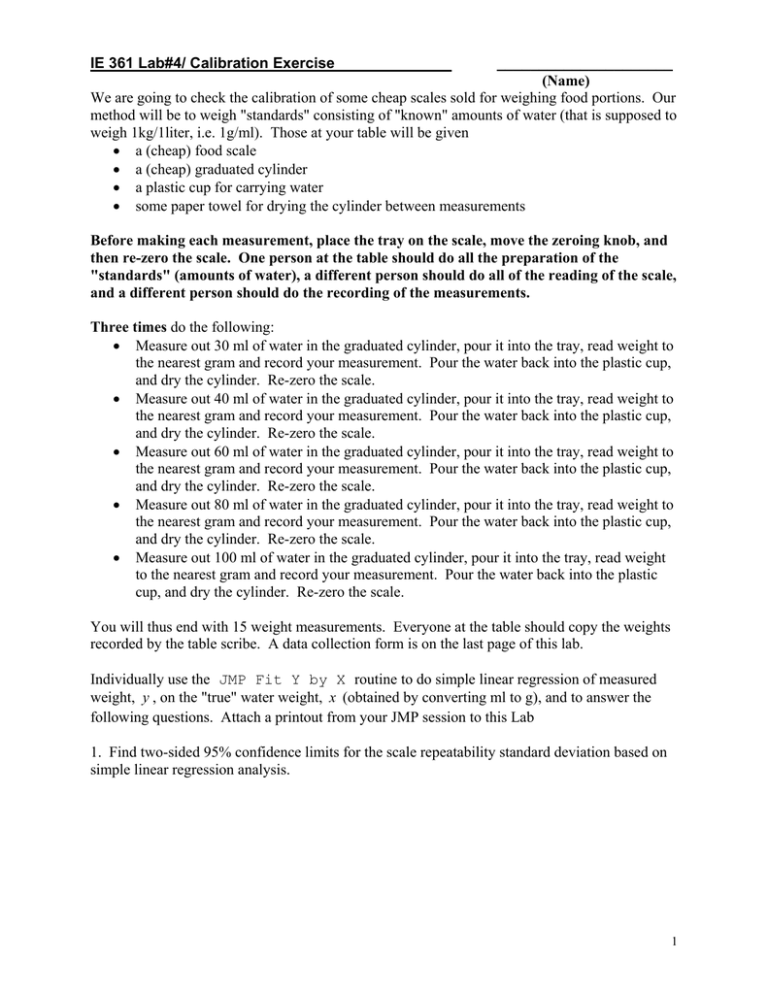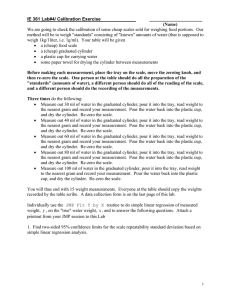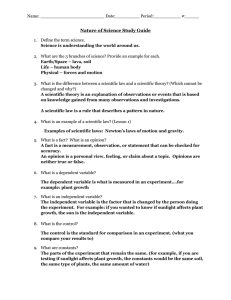IE 361 Lab#4/ Calibration Exercise _____________________ (Name)
advertisement

IE 361 Lab#4/ Calibration Exercise _____________________ (Name) We are going to check the calibration of some cheap scales sold for weighing food portions. Our method will be to weigh "standards" consisting of "known" amounts of water (that is supposed to weigh 1kg/1liter, i.e. 1g/ml). Those at your table will be given a (cheap) food scale a (cheap) graduated cylinder a plastic cup for carrying water some paper towel for drying the cylinder between measurements Before making each measurement, place the tray on the scale, move the zeroing knob, and then re-zero the scale. One person at the table should do all the preparation of the "standards" (amounts of water), a different person should do all of the reading of the scale, and a different person should do the recording of the measurements. Three times do the following: Measure out 30 ml of water in the graduated cylinder, pour it into the tray, read weight to the nearest gram and record your measurement. Pour the water back into the plastic cup, and dry the cylinder. Re-zero the scale. Measure out 40 ml of water in the graduated cylinder, pour it into the tray, read weight to the nearest gram and record your measurement. Pour the water back into the plastic cup, and dry the cylinder. Re-zero the scale. Measure out 60 ml of water in the graduated cylinder, pour it into the tray, read weight to the nearest gram and record your measurement. Pour the water back into the plastic cup, and dry the cylinder. Re-zero the scale. Measure out 80 ml of water in the graduated cylinder, pour it into the tray, read weight to the nearest gram and record your measurement. Pour the water back into the plastic cup, and dry the cylinder. Re-zero the scale. Measure out 100 ml of water in the graduated cylinder, pour it into the tray, read weight to the nearest gram and record your measurement. Pour the water back into the plastic cup, and dry the cylinder. Re-zero the scale. You will thus end with 15 weight measurements. Everyone at the table should copy the weights recorded by the table scribe. A data collection form is on the last page of this lab. Individually use the JMP Fit Y by X routine to do simple linear regression of measured weight, y , on the "true" water weight, x (obtained by converting ml to g), and to answer the following questions. Attach a printout from your JMP session to this Lab 1. Find two-sided 95% confidence limits for the scale repeatability standard deviation based on simple linear regression analysis. 1 2. Use the fitted least squares line and give an estimated weight ( x ) if (in the future) the scale reads y 67 gram. 3. Have JMP add traces of 95% prediction limits for y to the plot of the least squares line and use the JMP cross-hair tool to read off 95% confidence limits for a weight x if the scale reads y 67 . 4. The scale has a "linearity" property if its bias is constant, or if y|x 0 1.0 x (i.e. 1 1.0 in the simple linear regression model). Use the estimated slope and the standard error of that estimate on the JMP report to make 95% confidence limits for 1 . From these, does it seem possible that the scale has constant bias over the range 30 grams to 100 grams? Explain. 2 Amount of Water (ml), x Measured Weight (grams), y 30 40 60 80 100 30 40 60 80 100 30 40 60 80 100 3





